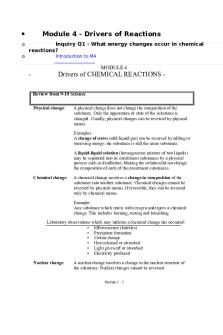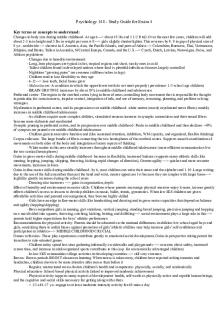GE3, Study Guide 4 - Lecture notes 4 PDF

| Title | GE3, Study Guide 4 - Lecture notes 4 |
|---|---|
| Course | Art Appreciation |
| Institution | Pangasinan State University |
| Pages | 5 |
| File Size | 144.4 KB |
| File Type | |
| Total Downloads | 235 |
| Total Views | 581 |
Summary
Download GE3, Study Guide 4 - Lecture notes 4 PDF
Description
Elements and Principles of Visual Arts This chapter talks about the artists’ employment of the different visual qualities in creating his/her masterpiece. These qualities are called the elements. These elements of the visual arts together with the principles of design help the artist to communicate his ideas about a certain subject. The elements of the visual arts include line, shape, space, form, color, value, and texture. Whereas balance, emphasis, rhythm, harmony and proportion comprise the principles of design.
Elements and Principles of Art
The elements of art and design are considered as the building blocks of art. These are the basics we use in communicating our views and thoughts about a certain idea. Likewise, these are the tools that the artist uses to create an exceptional composition of thoughts. The principles of art represent how the artist uses the elements of art to create an effect and to help how the artist’s intent (Marder, 2019.) Moreover, the use of these principles can help determine whether a painting is successful, and whether or not a certain artwork is finished.
I.
Elements of Visual Art A. Line – line is simplest, most basic, most ancient and most universal means for creating visual art among all other art elements. Through lines, neither thick nor thin, artist can make a concrete representation of shapes and forms of a figure as well as making objects stand out against a background for better effect and design.
Types of Line i.
ii.
iii.
Horizontal Line – this type of line is parallel to the horizon and do not slant. When you lie down on a flat surface, your body forms a horizontal line. Horizontal line in art usually indicates calmness and rest. Landscapes and seascapes are primarily horizontals. Vertical Line – they start from bottom going up or vice versa. They do not lean. Verticals show strength, balance, and stability. Monuments, pillars and tall trees also represent a vertical line. Diagonal Line – Diagonals look as if they are either rising or falling. Diagonal lines suggest movement as well as stress, frustration, chaos and
iv.
violence. Curved/Curvilinear Line – they are organic, and natural and adjust direction regularly. This line was represented by wiggly lines forming wavy lines that display graceful movements.
B. Shape – shapes result from the crossing of lines enclosing an area and separating it from its surrounding (Fichner, 2019.) Shape is the principal element if identification for it gives the figure the form. Shape could be 2dimensional or 3-dimensional. 2-D has length and width, while 3-D has length, width, and volume. Categories of Shape 1. Geometric Shapes – are regular and precise and present an industrial feel to the viewers. It is also known as machine generated or man-made shapes. Geometric shape includes circle, triangle, square and the like. 2. Organic Shapes – these shapes are derived from any living organism. Oftentimes we see them in nature and with characteristics that are freeflowing, informal and irregular. Trees, flowers, birds, fishes, and even sea shells are organic shapes. C. Form – this refers to the quality or likeness of an entire mass, e.g. form of a woman, form a dog. Form could be 2 dimensional or 3 dimensional. 2dimensional arts are usually flat such as drawing and/or painting which consists length and width. 3-dimensional arts have mass, which take up length, width and volume. D. Space – an area above, below, between or within things where other art elements can interact. Positive space is the space occupied by an object or figure while negative space are the empty areas. E. Color – also known as hue. Color is considered as the most expressive of all the elements of the art. It is also easily recognized in any visual experiences. Its primary source is from the light where visible light carries all the colors. Properties of Color 1. Hue – it gives the color its name and the property which distinguishes one color from another. 2. Value – is the lightness or darkness of a hue or a color. The value could be changed by adding black (shading) or white (tinting). Value is also the relationship of blacks, whites and grays. 3. Intensity – also known as saturation. Intensity refers to the brightness or dullness of color. Classification of Color 1. Primary Colors – also known as the Original Colors. Red, blue and
yellow. 2. Secondary Colors – are produced by combining 2 primary colors. Orange, Green and violet.
3. Tertiary Colors – can result from a combination of a primary and secondary color. Red-orange, yellow-orange, red-violet, blue-violet, yellow-green, blue-green. F. Texture – this element taps into sensory systems specifically our sense of touch. The element of texture can be defined as how the surface of the material or object feels and looks like. Moreover, texture can also be actual or implied texture. Applied texture refers to the real “feel” and look of the surface of the object while implied texture refers to the character of texture as shown by the artist in the artwork. II.
Principles of Design The principles of design characterize how the artist manage the elements of art to generate an effect and aid to convey his/her message. Basically, these are the strategies in creating a good and beautiful design. Thus, the effectiveness of elements of art will depend in the proper usage and manipulation of the principles of design which is the guiding principles and rules in art. The principles of design are the following: 1. Balance – the principle of balance refers to the visual equilibrium which gives the vieers the feeling of stability and equality in terms of visual weight of the elements in the composition. Therefore, visual weight should be equally distributed on each side of the focal point. Types of Balance a. Symmetrical Balance – is the most stable among the kinds of balance. It is also known as formal balance. Two equal parts of the pictorial plane of an artwork placed like mirror images of each other. b. Asymmetrical Balance – also known as informal or occult balance. Elements on either side of a composition does not reflect one another. Further, this type of balance displays the other side is dominant than the other. c. Radial Balance – balance radiate out from the center point in a circular fashion to all sides or direction. 2. Emphasis – the principle of emphasis is when the artist creates an area in the composition that is visually dominant and commands the viewer’s
3.
4. 5. 6. 7.
attention towards a particular area. Moreover, emphasis is often achieved by contrast. This principle gives importance to what truly matters in the artwork. Rhythm – is the regular repetition of elements that can produce implied visual movement. Artist create visual rhythm by repeating art elements as well as creating patterns. In this principle of design displays continuance, a flow, or a feeling of movement by either repetition or repetition with alternation of regulated visual elements. Harmony – this principle can also be described as sameness, the belonging of one thing with another. Unity – there is unity if all the elements in a composition work together toward a unified meaning. Variety – this principle creates an interest and appeal un a body of work. Using differences and change may result to increasing visual interest. Proportion or Scale – the comparative relationship of one part to another with regards to size. Proportions give a sense of size seen as a relationship of objects. Moreover, proportion enhances the realistic appeal of an artwork.
SUMMARY
The elements of art are color, form, line, shape, space, and texture. The principles of art are, proportion, unity, variety, rhythm, balance, volume, and harmony. Understanding the art methods will help define and determine how the culture created the art and for what use.
REFERENCES: 1. Textbook in Art Appreciation by Punzalan, J.F. et.al. 2. Gardner’s Art through the Ages: A Concise History of Western Art, Fred S. Kleiner, 3rd ed, 2012, pp. 1-2 3. Imagination in Teaching and Learning, Kieran Egan, 1992, pp. 12-37 4. Nature and Young Children, 2nd ed., Encouraging Creative Play and Learning in Natural Environments, Ruth Wilson, 2012, pp 1-17 5. Art Perception and Appreciation, Ortiz et al, 1976, pp 5-12 6. The Humanities, Dudley and Fancy, 1988, pp. 5-22 (Nature of Art) 7. Alampat: An Introduction to Art Appreciation, Perez, Cayas, and Narciso, 2013, pp. 9-12, 15-21. 8. The Humanities, Dudley Fancy and Rice, 1968, pp. 5-12 9. “The Philosophical Concept of Beauty” Jacques Maritain (from Creative Intuition in Art and Poetry), 1953, pp. 122-127
10. Aesthetics and Art Theory, Osborne, 1970,, pp. 104-107, 142-144, 171-191, 226-283 11. Myths and Symbols Philippines, Francisco Demetrio, SJ, 1978, pp. 406-411 12. MAKING THE THEATRE The Craft of the Stage, Steven Patrick C. Fernande, 2010, pp. 15-20 13. Merce Cunningham: Fifty Years, Vaughan and Harris, 1997, pp.10, 60-61, 100-101 (dance technique) 14. Nature and Young Children 2nd ed, Encouraging Creative Play and Learning in Natural Environments, Ruth Wilson, 2012, pp.3-17 15. Choreography: A Basic Approach Using Improvisation, Minton, 1986, pp. 18-19 16. Improvisation for the Theater, Spolin, 3rd ed., 1999 (entire book) 17. Culture of Improvisation, Antolihao, 2004, pp.83-84 18. Fundamentals of Art Appreciation, Pagay et. al. 2018. 19. Art Appreciation, Panisan et. al. 2018. 20. A Course Module for Art Appreciation, Roldan et. al. 2019, 21. https://www.liveabout.com/principles-of-art-and-design-2578740...
Similar Free PDFs

Lecture Exam 4 Study Guide
- 3 Pages

Exam 4 Study Guide
- 22 Pages

Chapter 4 Study Guide
- 4 Pages

Chapter 4 Study Guide
- 11 Pages

Module 4 study guide
- 36 Pages

Unit 4 study guide
- 14 Pages

Study Guide, Test 4
- 16 Pages

Exam 4 Study Guide
- 4 Pages

Study guide exam 4
- 6 Pages

Study guide 2-4
- 6 Pages

Exam 4 Study Guide
- 5 Pages
Popular Institutions
- Tinajero National High School - Annex
- Politeknik Caltex Riau
- Yokohama City University
- SGT University
- University of Al-Qadisiyah
- Divine Word College of Vigan
- Techniek College Rotterdam
- Universidade de Santiago
- Universiti Teknologi MARA Cawangan Johor Kampus Pasir Gudang
- Poltekkes Kemenkes Yogyakarta
- Baguio City National High School
- Colegio san marcos
- preparatoria uno
- Centro de Bachillerato Tecnológico Industrial y de Servicios No. 107
- Dalian Maritime University
- Quang Trung Secondary School
- Colegio Tecnológico en Informática
- Corporación Regional de Educación Superior
- Grupo CEDVA
- Dar Al Uloom University
- Centro de Estudios Preuniversitarios de la Universidad Nacional de Ingeniería
- 上智大学
- Aakash International School, Nuna Majara
- San Felipe Neri Catholic School
- Kang Chiao International School - New Taipei City
- Misamis Occidental National High School
- Institución Educativa Escuela Normal Juan Ladrilleros
- Kolehiyo ng Pantukan
- Batanes State College
- Instituto Continental
- Sekolah Menengah Kejuruan Kesehatan Kaltara (Tarakan)
- Colegio de La Inmaculada Concepcion - Cebu




